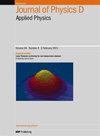Inhibit ammonia volatilization from agriculture and livestock by air plasma-activated water
IF 3.2
3区 物理与天体物理
Q2 PHYSICS, APPLIED
引用次数: 0
Abstract
Ammonia volatilization in agriculture and livestock is a considerable cause of air pollution and a significant way of N loss. In this study, we propose a method of using air plasma-activated water (PAW) to inhibit ammonia volatilization from agriculture and livestock and report the inhibitory effect under different discharge times and concentration gradients. PAW was generated through needle–water discharge, while ammonia waters with different concentrations served as simplified models for ammonia release. The compositions of the gas/liquid products of the PAW and those after mixing with ammonia water were detected and analyzed. It was found that the PAW could effectively inhibit the NH3 volatilization from ammonia water over a large range of conditions, however, NH3 volatilization promotion could also happen in some cases. The inhibition rate (IR) generally increased with the longer discharge time of the PAW and decreased with the higher ammonia water concentration. As the discharge time increased, the PAW became more acidic and had more active N components, converting more volatile NH3 to NH4 + when mixed with ammonia water. Finally, a relationship model was developed between the IR and pH of the mixture. The IR basically decreased with the increase of the mixture pH, and reached ∼100% when a PAW with a discharge time of 7.5 min or 10 min was mixed with ammonia water with a mass fraction of 0.15%, or PAW of 10 min mixed with 0.25% ammonia water in this study, with the mixture pH lower than 8. The basic chemical process and possible reaction mechanisms were discussed. The proposed method not only effectively reduces ammonia volatilization but also adds more N elements in the form of NO3 − and NH4 +, which further improves fertility.利用空气等离子体活化水抑制农业和畜牧业中的氨挥发
农业和畜牧业中的氨挥发是造成空气污染的一个重要原因,也是氮流失的一个重要途径。本研究提出了一种利用空气等离子活化水(PAW)抑制农牧业氨挥发的方法,并报告了不同排放时间和浓度梯度下的抑制效果。空气等离子活化水通过针-水排放产生,不同浓度的氨水作为氨释放的简化模型。检测并分析了 PAW 的气/液产物以及与氨水混合后的气/液产物的成分。结果发现,在很大的条件范围内,PAW 能有效抑制氨水中 NH3 的挥发,但在某些情况下也会促进 NH3 的挥发。抑制率(IR)一般随着 PAW 排放时间的延长而增加,随着氨水浓度的增加而降低。随着排放时间的延长,PAW 的酸性增强,活性 N 成分增多,与氨水混合后可将更多挥发性 NH3 转化为 NH4+。最后,在混合液的 IR 值和 pH 值之间建立了一个关系模型。放电时间为 7.5 分钟或 10 分钟的 PAW 与质量分数为 0.15%的氨水混合时,IR 值基本上随混合物 pH 值的增加而降低,达到了 100%;在本研究中,放电时间为 10 分钟的 PAW 与质量分数为 0.25%的氨水混合时,IR 值达到了 100%,混合物 pH 值低于 8。所提出的方法不仅能有效减少氨的挥发,还能以 NO3- 和 NH4+ 的形式增加氮元素,从而进一步提高肥效。
本文章由计算机程序翻译,如有差异,请以英文原文为准。
求助全文
约1分钟内获得全文
求助全文
来源期刊
CiteScore
6.80
自引率
8.80%
发文量
835
审稿时长
2.1 months
期刊介绍:
This journal is concerned with all aspects of applied physics research, from biophysics, magnetism, plasmas and semiconductors to the structure and properties of matter.

 求助内容:
求助内容: 应助结果提醒方式:
应助结果提醒方式:


